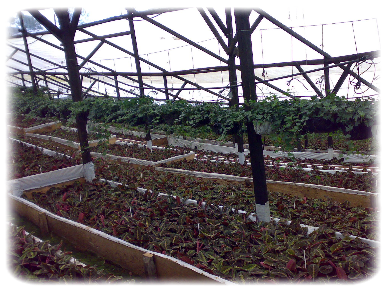La Floresta Ornamentales
Cultural Information
Cultural Information
Peperomia Obtusifolia
Itís ideal for tropical groundcover use, as well as container culture or raised planters, seldomly grows taller than 12 inches, suitable for growing indoors, will grow in shade and is moderately drought tolerant. Peperomia will thrive in moist, rich, organic soils but tolerates slightly alkaline soil, clay or sand; let it dry between watering. Its most common pests and diseases are mites, leaf spots and stem and root rotting.
Maranta Leuconeura `Erythroneur
Known as Red Maranta. Itís a small tropical plant with broad oval leaves up to 5 inches (12 cm) long by half as wide. It likes a bright place without sun, can be planted in regular potting mix, must be kept constantly moist but not wet. It can reach up to 10 inches (25 cm) in height and make great, showy container plants.

Hedera Helix
It is widely used as a climber to cover walls, fences and trellises. It is also one of the most common ground covers because of its ability to avoid soil erosion and slippage on slopes. Several ivy types are suitable for growing as interior house plants, topiaries and on hanging baskets. Ivy tolerates a wide range of soils but prefers rich loams. Green ivies are highly tolerant of shade ; variegated ivies prefer part sun. It tolerates drought and high-heat conditions, but enjoys a periodic deep watering. Pruning 2 or 3 times a year will promote its growth and avoid fungus and leaf spots. The most common ivy pests are spider mites, mealybugs, aphids and white flies.
Cissus Rhombifolia
Allow to become almost dry, and then water thoroughly so that water drains out of the bottom of the pot. Any well drained soil will do fine.not expose to direct sun as leaves might scorch or burn, Cissus will do great in low to high indoor light. To form a nice and bushy plant, pinch cissus often at all the points where the new growth comes out.
